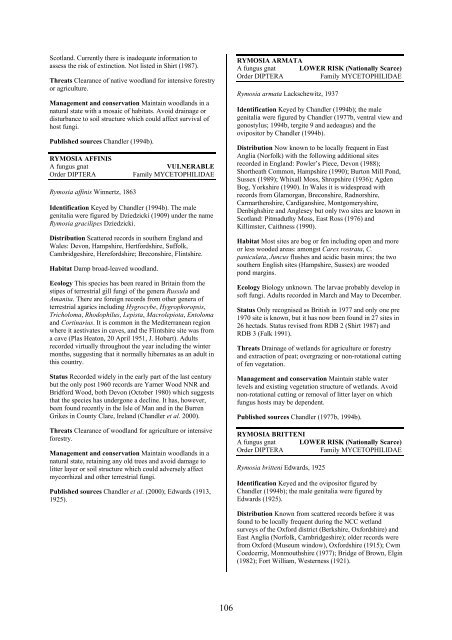Part 2: Nematocera and Aschiza not dealt with by Falk (1991) - JNCC
Part 2: Nematocera and Aschiza not dealt with by Falk (1991) - JNCC
Part 2: Nematocera and Aschiza not dealt with by Falk (1991) - JNCC
You also want an ePaper? Increase the reach of your titles
YUMPU automatically turns print PDFs into web optimized ePapers that Google loves.
Scotl<strong>and</strong>. Currently there is inadequate information to<br />
assess the risk of extinction. Not listed in Shirt (1987).<br />
Threats Clearance of native woodl<strong>and</strong> for intensive forestry<br />
or agriculture.<br />
Management <strong>and</strong> conservation Maintain woodl<strong>and</strong>s in a<br />
natural state <strong>with</strong> a mosaic of habitats. Avoid drainage or<br />
disturbance to soil structure which could affect survival of<br />
host fungi.<br />
Published sources Ch<strong>and</strong>ler (1994b).<br />
RYMOSIA AFFINIS<br />
A fungus gnat<br />
Order DIPTERA<br />
Rymosia affinis Winnertz, 1863<br />
VULNERABLE<br />
Family MYCETOPHILIDAE<br />
Identification Keyed <strong>by</strong> Ch<strong>and</strong>ler (1994b). The male<br />
genitalia were figured <strong>by</strong> Dziedzicki (1909) under the name<br />
Rymosia gracilipes Dziedzicki.<br />
Distribution Scattered records in southern Engl<strong>and</strong> <strong>and</strong><br />
Wales: Devon, Hampshire, Hertfordshire, Suffolk,<br />
Cambridgeshire, Herefordshire; Breconshire, Flintshire.<br />
Habitat Damp broad-leaved woodl<strong>and</strong>.<br />
Ecology This species has been reared in Britain from the<br />
stipes of terrestrial gill fungi of the genera Russula <strong>and</strong><br />
Amanita. There are foreign records from other genera of<br />
terrestrial agarics including Hygrocybe, Hygrophoropsis,<br />
Tricholoma, Rhodophilus, Lepista, Macrolepiota, Entoloma<br />
<strong>and</strong> Cortinarius. It is common in the Mediterranean region<br />
where it aestivates in caves, <strong>and</strong> the Flintshire site was from<br />
a cave (Plas Heaton, 20 April 1951, J. Hobart). Adults<br />
recorded virtually throughout the year including the winter<br />
months, suggesting that it normally hibernates as an adult in<br />
this country.<br />
Status Recorded widely in the early part of the last century<br />
but the only post 1960 records are Yarner Wood NNR <strong>and</strong><br />
Bridford Wood, both Devon (October 1980) which suggests<br />
that the species has undergone a decline. It has, however,<br />
been found recently in the Isle of Man <strong>and</strong> in the Burren<br />
Grikes in County Clare, Irel<strong>and</strong> (Ch<strong>and</strong>ler et al. 2000).<br />
Threats Clearance of woodl<strong>and</strong> for agriculture or intensive<br />
forestry.<br />
Management <strong>and</strong> conservation Maintain woodl<strong>and</strong>s in a<br />
natural state, retaining any old trees <strong>and</strong> avoid damage to<br />
litter layer or soil structure which could adversely affect<br />
mycorrhizal <strong>and</strong> other terrestrial fungi.<br />
Published sources Ch<strong>and</strong>ler et al. (2000); Edwards (1913,<br />
1925).<br />
RYMOSIA ARMATA<br />
A fungus gnat LOWER RISK (Nationally Scarce)<br />
Order DIPTERA<br />
Family MYCETOPHILIDAE<br />
Rymosia armata Lackschewitz, 1937<br />
Identification Keyed <strong>by</strong> Ch<strong>and</strong>ler (1994b); the male<br />
genitalia were figured <strong>by</strong> Ch<strong>and</strong>ler (1977b, ventral view <strong>and</strong><br />
gonostylus; 1994b, tergite 9 <strong>and</strong> aedeagus) <strong>and</strong> the<br />
ovipositor <strong>by</strong> Ch<strong>and</strong>ler (1994b).<br />
Distribution Now known to be locally frequent in East<br />
Anglia (Norfolk) <strong>with</strong> the following additional sites<br />
recorded in Engl<strong>and</strong>: Powler’s Piece, Devon (1988);<br />
Shortheath Common, Hampshire (1990); Burton Mill Pond,<br />
Sussex (1989); Whixall Moss, Shropshire (1936); Agden<br />
Bog, Yorkshire (1990). In Wales it is widespread <strong>with</strong><br />
records from Glamorgan, Breconshire, Radnorshire,<br />
Carmarthenshire, Cardiganshire, Montgomeryshire,<br />
Denbighshire <strong>and</strong> Anglesey but only two sites are known in<br />
Scotl<strong>and</strong>: Pitmaduthy Moss, East Ross (1976) <strong>and</strong><br />
Killimster, Caithness (1990).<br />
Habitat Most sites are bog or fen including open <strong>and</strong> more<br />
or less wooded areas: amongst Carex rostrata, C.<br />
paniculata, Juncus flushes <strong>and</strong> acidic basin mires; the two<br />
southern English sites (Hampshire, Sussex) are wooded<br />
pond margins.<br />
Ecology Biology unknown. The larvae probably develop in<br />
soft fungi. Adults recorded in March <strong>and</strong> May to December.<br />
Status Only recognised as British in 1977 <strong>and</strong> only one pre<br />
1970 site is known, but it has now been found in 27 sites in<br />
26 hectads. Status revised from RDB 2 (Shirt 1987) <strong>and</strong><br />
RDB 3 (<strong>Falk</strong> <strong>1991</strong>).<br />
Threats Drainage of wetl<strong>and</strong>s for agriculture or forestry<br />
<strong>and</strong> extraction of peat; overgrazing or non-rotational cutting<br />
of fen vegetation.<br />
Management <strong>and</strong> conservation Maintain stable water<br />
levels <strong>and</strong> existing vegetation structure of wetl<strong>and</strong>s. Avoid<br />
non-rotational cutting or removal of litter layer on which<br />
fungus hosts may be dependent.<br />
Published sources Ch<strong>and</strong>ler (1977b, 1994b).<br />
RYMOSIA BRITTENI<br />
A fungus gnat LOWER RISK (Nationally Scarce)<br />
Order DIPTERA<br />
Family MYCETOPHILIDAE<br />
Rymosia britteni Edwards, 1925<br />
Identification Keyed <strong>and</strong> the ovipositor figured <strong>by</strong><br />
Ch<strong>and</strong>ler (1994b); the male genitalia were figured <strong>by</strong><br />
Edwards (1925).<br />
Distribution Known from scattered records before it was<br />
found to be locally frequent during the NCC wetl<strong>and</strong><br />
surveys of the Oxford district (Berkshire, Oxfordshire) <strong>and</strong><br />
East Anglia (Norfolk, Cambridgeshire); older records were<br />
from Oxford (Museum window), Oxfordshire (1915); Cwm<br />
Coedcerrig, Monmouthshire (1977); Bridge of Brown, Elgin<br />
(1982); Fort William, Westerness (1921).<br />
106
















